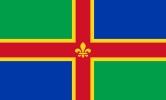Bardney Abbey



Bardney Abbey in Lincolnshire, England, was a Benedictine monastery founded in 697[1] by King Æthelred of Mercia, who was to become the first abbot. The monastery is supposed to have been destroyed during a Danish raid in 869.[2] In 1087 it was refounded as a priory, by Gilbert de Gant, Earl of Lincoln, and it regained status as an abbey in 1115.[2][3][4]
In 1537, six of the monks were executed for their role in the Lincolnshire Rising, and Dissolution followed.[2][3][5] In the following year, the property was granted to Sir Robert Tirwhit. He retained the abbot's lodging as a house, and the cloister became a garden, though both later became ruinous along with the remainder of the monastery.[5]
Excavations in 1909–14 revealed the layout. This can still be seen, though nothing remains to any height. Further excavations and conservation took place in 2009[6] and 2011.[7] Some grave slabs and carved stones are preserved in Bardney parish church, which is dedicated to St Lawrence.[8][9]
Relics of St Oswald
Known abbots of Bardney
This list is taken from the Victoria County History,[3] and Bowyer's History of the Mitred Parliamentary Abbies.[4]
Original foundation
- St. Ethelred, ex-king of Mercia, made abbot about 704, died 716
- Kenewin, occurs 833
Benedictine foundation
- Ralf, prior in 1087, abbot 1115
- Ivo, occurs about 1133
- John of Ghent, elected 1140, occurs 1147 and 1150
- Walter, occurs 1155 to 1166
- John, occurs 1167
- Ralf of Stainfield, occurs 1180
- Robert, occurs 1191
- Ralf de Rand, occurs 1208, deposed 1214
- Peter of Lenton, intruded 1214
- Matthew, occurs 1218, died 1223
- Adam de Ascwardby, elected 1225, occurs 1231 and 1240
- William of Ripton
- Walter of Benningworth, elected 1241, deposed 1243
- William of Hatton,elected 1244
- William of Torksey, elected 1258, died 1266
- Peter of Barton, elected 1266, resigned 1280
- Robert of Wainfleet, elected 1280, resigned 1318[10]
- Richard of Gainsborough, elected 1318, died 1342
- Roger of Barrow, elected 1342, died 1355
- Thomas of Stapleton, elected 1355, died 1379
- Hugh of Braunston, elected 1379, resigned 1385
- John of Haynton, elected 1385
- John Woxbrigge, elected 1404, died 1413
- Geoffrey Hemingsby, elected 1413, died 1435
- John Wainfleet, elected 1435, died 1447[11]
- Gilbert Multon, elected 1447, resigned 1466
- Richard Horncastle, elected 1466, resigned 1507
- William Marton, last abbot, elected 1507
Further reading
- New, Anthony (1985). A guide to the abbeys of England and Wales. Constable. pp. 44–45. ISBN 0-09-463520-X. OCLC 246863338.
- "Bardney Village History". Bardney Heritage Centre, Station road, Bardney, LN3 5UF: Bardney Heritage Group. 2013. Retrieved 4 April 2013.
{{cite web}}:|chapter=ignored (help)CS1 maint: location (link) Includes finds record and floor plan from 1909 excavation. - Laing, Charles Edward (1913). Some notes on Bardney Abbey.
- An organisation called The Association of friends of Bardney Abbey existed from 1975 to 1993,[12] and published a number of monographs in the 1970s whose titles and authors are listed by a number of internet sources but the actual works are more elusive.
- Beech, George (1989). Patterson, Robert B (ed.). "Antiquarians and Flemings in the refoundation of Bardney Abbey (Lincolnshire) in the later 11th century". Haskins Society Journal. 1: 73–90. Retrieved 4 April 2013, describing the refoundation of the Abbey by Gilbert de Gant with monks from Charroux.
See also
References
- ^ This date comes from the National Monument record, but according to Bede the abbey already existed when Oswald was interred there in 679
- ^ a b c Historic England. "Bardney Abbey (351575)". Research records (formerly PastScape). Retrieved 10 April 2010.
- ^ a b c "Houses of Benedictine monks: The abbey of Bardney". A History of the County of Lincoln: Volume 2. Victoria County History. 1906. pp. 97–104. Retrieved 3 April 2013.
- ^ a b Bowyer, W. (1718). An History of the Mitred Parliamentary Abbies, and Conventual Cathedral Churches. Retrieved 4 April 2013.
- ^ a b Historic England. "House and Garden (1058729)". Research records (formerly PastScape). Retrieved 10 April 2010.
- ^ Cope-Faulkener, Paul (December 2009). Archaeological evaluation at Bardney Abbey (BASM09 12/09) (PDF). Heckington: Archaeological Project Services. Retrieved 4 April 2013. Report on 2009 investigation, includes detailed floor plan.
- ^ "Bardney Abbey Revealled 2011". Lincolnshire county council. Retrieved 3 April 2013.
- ^ "New exhibition of sculpture from Bardney Abbey". Heritage Lottery Fund. 5 October 2012. Retrieved 4 April 2013.[permanent dead link]
- ^ "Bardney church". Bardney Heritage Group. Retrieved 3 April 2013.
- ^ Historic England. "Benedictine Cell (1301846)". Research records (formerly PastScape). Retrieved 4 April 2013.
- ^ Thompson, Pishey (1820). Collections for a topographical and historical account of Boston, and the hundred of Skirbeck. Boston: J.Noble. p. 28.
- ^ "The association of friends of Bardney Abbey". Charity Commission for England and Wales. 1993. Retrieved 4 April 2013.
- Churches in Lincolnshire
- Monasteries in Lincolnshire
- Anglo-Saxon monastic houses
- Benedictine monasteries in England
- 7th-century establishments in England
- 697 establishments in Europe
- 697 in England
- 1538 disestablishments in England
- Christian monasteries established in the 7th century
- Burial sites of the Royal House of Northumbria
- Burial sites of the House of Icel



